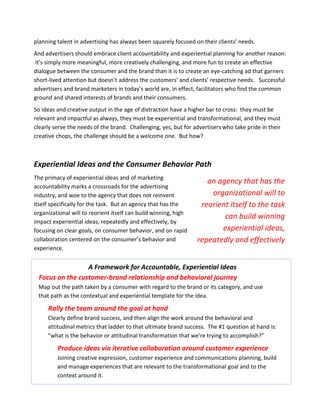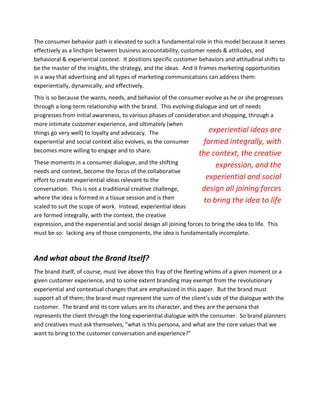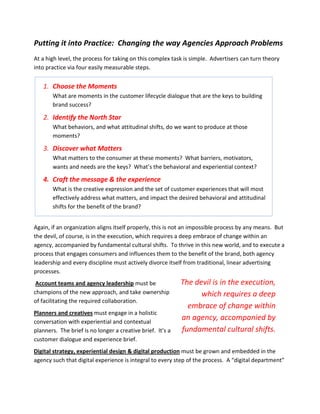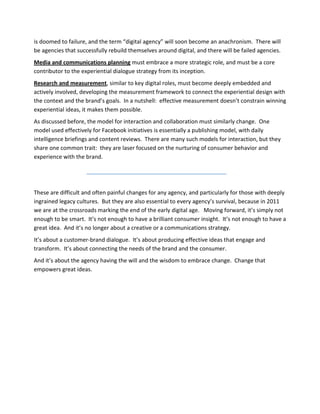Relevance and accountability in the age of distraction
- 1. Advertising Agencies at the Crossroads Relevance and accountability in the age of disruption By Tod Frincke, February, 2011 It’s tough to be an ad person in 2011. Not only do clients demand far greater accountability of their marketing investment’s impact on the bottom line than in the past, but advertisers must demonstrate these results in ever more fragmented and constantly evolving venues, with distracted and finicky consumers, and amid a tremendous din of commercial messaging. In this world, who could possibly hope to build meaningful brands and effective campaigns, consistently and with demonstrable results? A big part of the answer is as it ever was: knowing the consumer and being relevant to him or her. This was always an industry best practice, and a brand message that lacks relevance is still a marketing investment poured down the drain. Achieving and maintaining relevance is no easy task today, but with an eye on the ball and a bit of talent, it can be done. But relevance and breakthrough aren’t enough. Today, resonance and engagement are king and queen, and successful ideas are experiential and social, not static In today’s world of or one-directional. A static idea, if it resonates at all, will not be distraction, successful transformational: there’s simply too much distraction about. ideas are experiential Experiential ideas engage consumers in their own groups and activities. Experiential ideas seek to foster a conversation with and social, not static the consumer, as opposed to disrupting the conversation. Experiential ideas are not limited to digital, but digital is usually at their heart. Experiential ideas are intimate en masse, one consumer conversation at a time. Experiential ideas create an engaging platform for consumer action, growth, bonding, or sharing. And finally, while it’s great to deliver experiential work that engages the consumer, we are still left with the question “does it serve the needs of the brand?” Brand values that resonate profoundly with the consumer are winners only if they also position the brand for commercial success. Building brand awareness or favorability is only as important as the role of those metrics toward the brand’s business goals. And an Successful advertisers experiential idea that attracts and activates a million Facebook and brand marketers in fans is only as valuable as the customer loyalty and sharing today’s world are, in generated from it. effect, facilitators who In the past, some traditional advertisers would have taken find the common ground exception to all of this, and the supposed co-opting of the creative process. But the successful ones never did. They and shared interests of embraced their commercial role, and the best creative and brands and consumers.
- 2. planning talent in advertising has always been squarely focused on their clients’ needs. And advertisers should embrace client accountability and experiential planning for another reason: it's simply more meaningful, more creatively challenging, and more fun to create an effective dialogue between the consumer and the brand than it is to create an eye-catching ad that garners short-lived attention but doesn’t address the customers’ and clients’ respective needs. Successful advertisers and brand marketers in today’s world are, in effect, facilitators who find the common ground and shared interests of brands and their consumers. So ideas and creative output in the age of distraction have a higher bar to cross: they must be relevant and impactful as always, they must be experiential and transformational, and they must clearly serve the needs of the brand. Challenging, yes, but for advertisers who take pride in their creative chops, the challenge should be a welcome one. But how? Experiential Ideas and the Consumer Behavior Path The primacy of experiential ideas and of marketing an agency that has the accountability marks a crossroads for the advertising industry, and woe to the agency that does not reinvent organizational will to itself specifically for the task. But an agency that has the reorient itself to the task organizational will to reorient itself can build winning, high can build winning impact experiential ideas, repeatedly and effectively, by focusing on clear goals, on consumer behavior, and on rapid experiential ideas, collaboration centered on the consumer’s behavior and repeatedly and effectively experience. A Framework for Accountable, Experiential Ideas Focus on the customer-brand relationship and behavioral journey Map out the path taken by a consumer with regard to the brand or its category, and use that path as the contextual and experiential template for the idea. Rally the team around the goal at hand Clearly define brand success, and then align the work around the behavioral and attitudinal metrics that ladder to that ultimate brand success. The #1 question at hand is: “what is the behavior or attitudinal transformation that we’re trying to accomplish?” Produce ideas via iterative collaboration around customer experience Joining creative expression, customer experience and communications planning, build and manage experiences that are relevant to the transformational goal and to the context around it.
- 3. The consumer behavior path is elevated to such a fundamental role in this model because it serves effectively as a linchpin between business accountability, customer needs & attitudes, and behavioral & experiential context. It positions specific customer behaviors and attitudinal shifts to be the master of the insights, the strategy, and the ideas. And it frames marketing opportunities in a way that advertising and all types of marketing communications can address them: experientially, dynamically, and effectively. This is so because the wants, needs, and behavior of the consumer evolve as he or she progresses through a long-term relationship with the brand. This evolving dialogue and set of needs progresses from initial awareness, to various phases of consideration and shopping, through a more intimate customer experience, and ultimately (when things go very well) to loyalty and advocacy. The experiential ideas are experiential and social context also evolves, as the consumer formed integrally, with becomes more willing to engage and to share. the context, the creative These moments in a consumer dialogue, and the shifting expression, and the needs and context, become the focus of the collaborative effort to create experiential ideas relevant to the experiential and social conversation. This is not a traditional creative challenge, design all joining forces where the idea is formed in a tissue session and is then to bring the idea to life scaled to suit the scope of work. Instead, experiential ideas are formed integrally, with the context, the creative expression, and the experiential and social design all joining forces to bring the idea to life. This must be so: lacking any of those components, the idea is fundamentally incomplete. And what about the Brand Itself? The brand itself, of course, must live above this fray of the fleeting whims of a given moment or a given customer experience, and to some extent branding may exempt from the revolutionary experiential and contextual changes that are emphasized in this paper. But the brand must support all of them; the brand must represent the sum of the client’s side of the dialogue with the customer. The brand and its core values are its character, and they are the persona that represents the client through the long experiential dialogue with the consumer. So brand planners and creatives must ask themselves, "what is this persona, and what are the core values that we want to bring to the customer conversation and experience?"
- 4. Putting it into Practice: Changing the way Agencies Approach Problems At a high level, the process for taking on this complex task is simple. Advertisers can turn theory into practice via four easily measurable steps. 1. Choose the Moments What are moments in the customer lifecycle dialogue that are the keys to building brand success? 2. Identify the North Star What behaviors, and what attitudinal shifts, do we want to produce at those moments? 3. Discover what Matters What matters to the consumer at these moments? What barriers, motivators, wants and needs are the keys? What’s the behavioral and experiential context? 4. Craft the message & the experience What is the creative expression and the set of customer experiences that will most effectively address what matters, and impact the desired behavioral and attitudinal shifts for the benefit of the brand? Again, if an organization aligns itself properly, this is not an impossible process by any means. But the devil, of course, is in the execution, which requires a deep embrace of change within an agency, accompanied by fundamental cultural shifts. To thrive in this new world, and to execute a process that engages consumers and influences them to the benefit of the brand, both agency leadership and every discipline must actively divorce itself from traditional, linear advertising processes. Account teams and agency leadership must be The devil is in the execution, champions of the new approach, and take ownership which requires a deep of facilitating the required collaboration. embrace of change within Planners and creatives must engage in a holistic conversation with experiential and contextual an agency, accompanied by planners. The brief is no longer a creative brief. It’s a fundamental cultural shifts. customer dialogue and experience brief. Digital strategy, experiential design & digital production must be grown and embedded in the agency such that digital experience is integral to every step of the process. A “digital department”
- 5. is doomed to failure, and the term “digital agency” will soon become an anachronism. There will be agencies that successfully rebuild themselves around digital, and there will be failed agencies. Media and communications planning must embrace a more strategic role, and must be a core contributor to the experiential dialogue strategy from its inception. Research and measurement, similar to key digital roles, must become deeply embedded and actively involved, developing the measurement framework to connect the experiential design with the context and the brand’s goals. In a nutshell: effective measurement doesn’t constrain winning experiential ideas, it makes them possible. As discussed before, the model for interaction and collaboration must similarly change. One model used effectively for Facebook initiatives is essentially a publishing model, with daily intelligence briefings and content reviews. There are many such models for interaction, but they share one common trait: they are laser focused on the nurturing of consumer behavior and experience with the brand. These are difficult and often painful changes for any agency, and particularly for those with deeply ingrained legacy cultures. But they are also essential to every agency’s survival, because in 2011 we are at the crossroads marking the end of the early digital age. Moving forward, it’s simply not enough to be smart. It’s not enough to have a brilliant consumer insight. It’s not enough to have a great idea. And it’s no longer about a creative or a communications strategy. It’s about a customer-brand dialogue. It’s about producing effective ideas that engage and transform. It’s about connecting the needs of the brand and the consumer. And it’s about the agency having the will and the wisdom to embrace change. Change that empowers great ideas.





